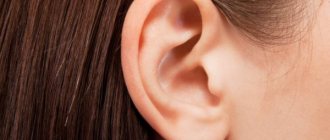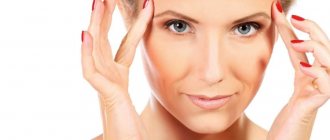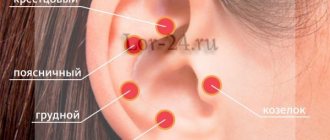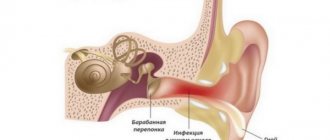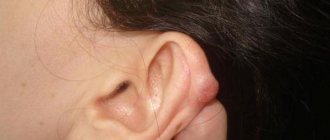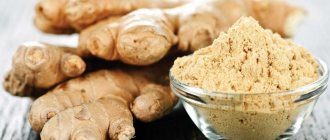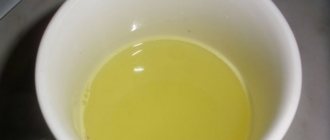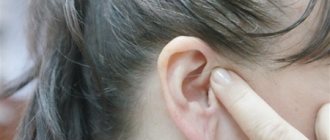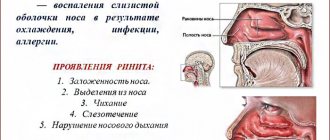Treatment of pain due to otitis media
Pain is an alarm signal that indicates to a person that there is a problem in his body. With otitis media, it occurs in the inflamed ear and can radiate to the temple, teeth, neck and even shoulder. The pain syndrome increases depending on the stage of the disease.
It reaches its peak with purulent otitis media, since the fluid accumulated in large quantities puts strong pressure on the swollen eardrum. All this is accompanied by ear congestion, hearing loss and high body temperature.
Sore throat, ear pain and headaches with otitis media sometimes become so unbearable that a person is ready to do anything to get rid of it. What to do in this case?
Pain relieving drops
The most effective pain reliever for otitis media is ear drops. They act quickly, are simple and easy to use. The only condition is that they must be prescribed by an otolaryngologist after diagnosis.
It is important to know that most anesthetic drops are indicated for use only if the eardrum is not perforated.
Otherwise, you can only harm an already diseased ear - damage to the hair cells of the ear, receptors and auditory nerve fibers is possible, which will lead to the development of hearing loss or hearing loss. This is how the ototoxic effect of drugs manifests itself.
Only a doctor can determine whether a rupture has occurred during a special examination. He will explain how best to relieve pain from otitis media.
The following types of drops are most often prescribed:
- Otipax, which contains phenazone, an analgesic substance that can relieve pain, and lidocaine, an anesthetic that reduces general sensitivity. These drops are considered relatively safe, with a minimum of side effects, and are therefore suitable for pregnant women and newborns. To achieve the effect, adults need to instill 3-4 drops 3 times a day; for children, two instillations will be sufficient.
- Otizol, the rapid action of which is provided by the powerful anesthetic benzocaine and phenylephrine, which constricts blood vessels and has an anti-edematous effect. You can use these painkillers for otitis in children starting from 6 months. For such crumbs, 1 drop is enough to relieve pain. For adults, the standard dosage is 3-4 drops. You can repeat the instillation up to 3 times a day.
- Anauran - drops with a pronounced anti-pain and antimicrobial effect. Contains lidocaine and neomycin. It must be remembered that the simultaneous use of Anaura with some antibiotics (gentamicin, streptomycin) enhances the ototoxic effect of the drops. These drops are not prescribed to babies under one year of age.
Before instillation, it is recommended to warm the drops slightly - when cold, they can cause dizziness and discomfort. To do this, just hold the bottle in your hand for a while. After instillation, plug your ear with cotton wool and lie down for 10 minutes with the affected ear facing up.
Remember that pain-relieving drops do not cure, they only relieve unpleasant pain. This is just one of the components of complex treatment of otitis media.
Pain relieving drugs
Often, when faced with unbearable pain in the ear, a person forgets that ordinary painkillers and anti-inflammatory tablets, which can be found in every home medicine cabinet, can also help relieve it.
Otolaryngologists for otitis media recommend non-steroidal anti-inflammatory drugs as pain relief. These remedies are good because they effectively fight pain and inflammation, are not addictive, have few side effects, and besides, they are not at all expensive. The group of such drugs is quite wide (about 50 items). But the most popular are:
- Paracetamol - effectively reduces pain. After taking the tablet, the active substance is quickly absorbed and enters the blood. Its action is to suppress the action of prostaglandins - substances that transmit pain signals to the human brain. Paracetamol is available in the form of syrup, tablets, suppositories, drops and solution for injection. Paracetamol must be given in compliance with the age-specific dosage of the drug indicated in the instructions or prescribed by a doctor.
- Ibuklin is a combination of paracetamol and ibuprofen. Paracetamol blocks pain signals, and ibuprofen has an even more powerful analgesic effect because it stops the synthesis of substances responsible for pain. Sore throat and ear, high temperature, aching joints - Ibuklin can cope with such symptoms without problems.
Most parents are worried about whether such drugs are given to their children. The World Health Organization has confirmed the complete safety of paracetamol and ibuprofen even for the youngest patients, starting from 3 months of age.
In addition, they are produced in forms that are very convenient for children: all babies happily take the sweet suspension, and rectal suppositories can be administered even when the baby is sleeping.
The main thing is that the mother gives the baby the medicine in the recommended age-appropriate dose and no more than 4 times a day - otherwise serious side effects may occur.
Boric acid
People began to use the analgesic and antiseptic properties of this drug back in the 19th century. Today, an alcohol solution of acid - boric alcohol - is more often used.
This remedy is also very popular, especially in the treatment of otitis; in terms of its effectiveness, it is even compared with the antibiotic ciprofloxacin.
But the properties of acid to accumulate and be slowly eliminated from the body require great caution when used, especially for treating children. How to use boric acid to relieve pain in an inflamed ear?
- You can drip boric alcohol (3-4 drops), after carefully cleaning the ear with a cotton swab dipped in a solution of hydrogen peroxide.
- The best way is to leave a turunda moistened with boric alcohol in the sore ear overnight.
Using boric alcohol in cases of damage to the eardrum, injuries or abrasions of the ear canal is strictly prohibited, as this can lead to hearing impairment.
If you don't have painkillers on hand
Many young mothers are familiar with the situation when the baby wakes up at night from severe pain in the ear, you can only see a doctor in the morning, and you don’t have the necessary medications at hand. How to relieve pain from otitis media in a child in this case? They will help you:
Warming compresses - they can be made from vodka or alcohol diluted with water (1/1). To do this, you need to take a gauze napkin and cut a hole in the middle for the ear. Moisten a napkin with a warming liquid and apply it to the area around the ear.
Insulate the top with a layer of cotton wool, wrap it with a warm scarf and leave for two hours. The compress will improve blood circulation, help soothe and relieve pain in the inflamed ear.
As a warming compress, you can use a regular heating pad or salt heated in a frying pan, wrapped in a canvas napkin.
It is important to remember that camphor preparations, so popular among adults, cannot be used to treat young children due to their high toxicity!
- Calendula tincture - for otitis, cotton wool turundas are soaked in it and inserted into the ear at night. This plant is called a natural antibiotic - it will certainly help relieve pain and inflammation during otitis media, but only if there is no purulent discharge from the ear.
- Geranium is a common houseplant whose essential oils have unique pain-relieving properties. It is enough to insert a leaf of this plant into the ear, and after some time the pain will subside. A compress made from mashed leaves and mixed with flour and alcohol also helps.
- Aloe juice - to prepare it you need to cut a leaf of the plant and keep it in the refrigerator for a day - folk healers say that this will enhance the therapeutic properties of the plant. Then squeeze out the juice and, after warming it slightly, drop 3-4 drops into your ear. You will not only say goodbye to pain, but also stop the inflammatory process.
- If you have otitis, do not self-medicate, consult a doctor and strictly follow his instructions. Take sick leave and stay at home - after all, during this period any stress is contraindicated. Be patient and the pain will surely subside.
Source: https://uhogn.ru/otit/lechenie-boli/
How to take Nurofen for ear pain?
Hospital patients often include people with developing hearing pathologies.
Otitis is considered a widespread disease, which in most cases occurs in children under three years of age. Such a disease is simultaneously determined by many symptoms, but only three manifestations remain pronounced: attacks of pain, inflammation of the affected part of the auditory organ, and increased body temperature. When it comes to treating otitis media, you need to act quickly.
It is advisable to immediately use the “correct” drugs that can simultaneously suppress the main part of the symptoms. Nurofen has been used for ear pain in children for a long time and has established itself as a multifunctional effective remedy.
How to relieve pain from otitis media?
The sensation of pain acts as a kind of alarm signal, which indicates to a person that there are malfunctions in his body.
With otitis media, it forms in the inflamed organ of hearing and can affect the temporal region, oral cavity, neck, and shoulder parts.
The increase in pain depends on the stage of the disease, so by the final stage of its development the condition becomes unbearable. Let's look at how to relieve pain from otitis media quickly and easily.
Features of choosing an anesthetic for otitis media
People suffering from an inflammatory process in the ear are often faced with the problem of choosing a topical drug. In the purulent form of otitis, the pain can be shooting and shooting and also have a sharp, pulsating character.
In addition, there is a possibility that it will irritate the temples, teeth, and forehead. Symptoms that are pronounced are a direct indication for pain relief.
Often in practice the situation is aggravated by the fact that the patient suffers from nasal congestion, hearing loss, and fever.
If you study the main types of painkillers indicated for otitis, they are as follows:
- topical drops;
- products in tablet form;
- preparations for parenteral administration;
- injection solutions.
The form of administration of the composition is selected by the treating specialist depending on the degree of progression and severity of symptoms.
Special pain relieving drops
This is the most effective quick-acting remedy, characterized by simplicity and ease of use. The condition is that the appointment must occur after consultation with an ENT doctor and an accurate diagnosis has been established.
The lion's share of such compositions is indicated for use only in the absence of perforation in the eardrum. Otherwise, there is a risk of causing colossal harm to the ear.
Traditionally, doctors prescribe the following types of drip formulations:
- OTIPAX is an analgesic drug that relieves pain and reduces the overall sensitivity index, it is safe and easy to use, the number of side effects and contraindications is reduced to zero;
- OTIZOL is a fast-acting drug that causes vasoconstriction, fights swelling, and can be easily used by both adult patients and children;
- ANAURAN is a drip composition that has a pronounced anti-pain effect and can fight microbial elements.
Before using any painkillers for otitis in adults and young patients, it is necessary to warm them up slightly, since drops instilled cold can lead to dizziness and other unpleasant feelings.
Nonsteroidal anti-inflammatory drugs
Otolaryngologists often recommend the use of NSAIDs as painkillers. They help fight inflammation and pain. In addition, the drugs are not addictive and have minimal side effects.
Despite the vastness of representatives of this group, experts usually prescribe a limited number of compounds:
- IBUCLIN is a drug that includes paracetamol and ibuprofen, it helps block pain signals, and also has a pronounced analgesic effect, because it stops the synthesis of certain substances. The product effectively copes with symptoms such as pain in the hearing organs, fever and heat, aches.
- PARACETAMOL is a drug that reduces pain. After consuming one tablet, it is further immediately absorbed and penetrates into the blood fluid. The action of the medication is to suppress the influence of prostaglandins - special substances that send pain signals to the human brain. Paracetamol is available for otitis media in the form of syrup, tablets and drops. The solution for injections is also relevant. Giving this composition to a child must be subject to mandatory dosage, depending on the patient’s age. It is indicated in the instructions, and can also be prescribed by the treating specialist.
The reliability and safety of the given compositions has been confirmed within the framework of WHO data, which guarantees their quality.
Effective formulations for children
In pediatric pediatric and ENT practice, only safe drugs are prescribed.
- ANALGIN. It is used only in extreme cases when there are appropriate medical indications. If you disobey, this can lead to anemia, lack of immune cells in the blood, and thrombocytopenia.
- KETOROLAC. The drug is prescribed for intravenous administration in case of severe pain. For the treatment of otitis, this composition is not used as an independent medicine.
- PARACETAMOL. This is a syrup that is prescribed at 10-15 mg depending on body weight. The number of times a day is 4-6, depending on the degree of damage.
- SARIDON. This drug is sold in tablet form and is prescribed to children over 12 years of age, half or a whole tablet twice or thrice a day.
- LIDOCAINE. It is included in many drops and is used 2-3 pieces three times a day for no more than one week.
The given compositions are effective in symptomatic treatment and are prescribed as auxiliary medications in combination with other medications.
So we looked at how to relieve pain from otitis media in a child, and what exactly should be done. Now it remains to study the list of actions in case of progression of the disease in an adult.
Medicines for adult patients
In the process of prescribing drugs, the doctor focuses on the general condition of the patient and the symptomatic picture. The following medications are most often prescribed to adult patients.
- KETOROLAC. They have the most pronounced analgesic effect. If we compare it with the effect of morphine, we can observe the following picture: 30 mg of this composition administered is identical to 12 mg of morphine. With all this, the drug is not addictive and does not affect brain receptors.
- PARACETAMOL. The product has the most pronounced antipyretic properties and relieves pain instantly. This is one of the safest NSAIDs, but in case of long-term use it can cause kidney problems.
- ANALGIN. The drug, in addition to the main effect, disrupts the process of pain signal transmission along the nerve fiber. It is prescribed for internal use, 1 piece 100 or 500 mg three times a day.
- SARIDON. This is a combination type product containing a large number of excipients that enhance each other’s effects. In case of otitis, it is taken 1-2 pills up to three times a day.
- LIDOCAINE. The product is classified as ear drops and can be used in the form of a spray. The duration of treatment should not exceed a week.
There are many painkillers for otitis in children and adult patients.
Folk remedies for pain relief for otitis media
If you don’t have medications on hand, or you want to avoid adverse reactions from pharmaceutical products, you can take alternative treatment measures. Here are some effective formulations.
- Calendula infusion. For otitis media, it is used to impregnate cotton wool turundas and inserted overnight. The plant is reputed to be a powerful natural antibiotic, so after taking it the pain will go away as if by hand.
- Geranium is a classic houseplant containing essential oils that have unique qualities. To get the desired result, you need to insert a leaf of the plant into the ear, and after some time the pain will subside.
- Aloe juice. To prepare this composition, you need to cut 1 leaf of the plant and keep it in the refrigerator for 24 hours. Connoisseurs of traditional medicine claim that this approach will enhance the therapeutic qualities of the plant. After this, all you have to do is squeeze out the juice, warm it up a little and drop 3-4 drops into your ear. You can say goodbye to pain and stop the inflammation process.
So we looked at how to relieve pain so that you feel great. The above measures will help you achieve the desired result and stay in good shape.
Source: https://lor-expert.ru/ears/otitis/kak-snyat-bol-pri-otite.html
Types of painkillers
Non-steroidal anti-inflammatory drugs, which have an analgesic effect, have become very popular in modern medicine. The products in this group are not addictive and are relatively affordable. The drug has a wide spectrum of action: eliminates tissue swelling, relieves fever, gradually reducing pain.
Nonsteroidal anti-inflammatory drugs include more than 50 different drugs in their group. It is worth noting that, with a general mechanism of action, NSAIDs have a pronounced analgesic and anti-inflammatory effect. The following drugs have greater analgesic ability:
- analgin;
- paracetamol;
- ketorolac.
The drugs in this group can eliminate pain of low and moderate intensity. Most often they are produced in tablet form for adults and in syrup format for children. The effect begins after 30 minutes of oral administration.
The second main group of painkillers are local analgesics. The drug has an analgesic effect only at the site of administration or external use. For the treatment of otitis media, the drug is most often used in the form of drops, as well as a spray.
Lidocaine can be considered one of the most effective and popular local analgesics. This drug quite effectively relieves the pain threshold by blocking ion channels. It is distinguished by its rapid action; 15 minutes after use, the patient feels a colossal analgesic effect. Helps cope with intense pain. Disadvantages of lidocaine include toxicity and a short-term analgesic effect.
The most effective analgesics
Nonsteroidal anti-inflammatory drugs include more than 50 drugs. Their main difference from each other is the speed and severity of anti-inflammatory and analgesic effects. The following are considered the most effective analgesics:
- “Analgin.”
- "Ketorolac".
- "Paracetamol".
- “Propyphenazone.”
Painkillers for otitis media in adults
When choosing a particular painkiller, the doctor focuses on the degree of pain threshold, age, body weight of the patient, and also takes into account concomitant diseases.
- Paracetamol – has a pronounced analgesic and antipyretic effect. Paracetamol is considered the safest and non-toxic non-steroidal anti-inflammatory drug that does not cause kidney damage. For adults, the recommended dose is 500-1000 mg per day with 4 doses.
- Otipax is a drug with local anesthetic and anti-inflammatory action, which includes a local anesthetic - lidocaine. Available in ear drop format. The optimal course of treatment is 10 days with 2-3 times a day, 3-4 drops. Before use, it is recommended to warm the drops in your palms. Possible allergic reaction in the form of irritation, itching, burning in the ear canal.
- Saridon is a combination drug that contains paracetamol, caffeine, and propyphenazole, which enhances the effect of paracetamol many times over. Caffeine promotes better blood circulation and improves the absorption of analgesics. The recommended dose is 1-2 tablets per day with 1-3 times of use.
- Lidocaine is a local anesthetic in spray or ampoules format. You can make a cotton tourniquet, soak it in lidocaine and carefully place it in the ear canal.
Painkillers for otitis media in children
When choosing a painkiller for your child, you need to make sure that the drug is safe. In most cases, paracetamol and ibuprofen are used to eliminate pain from otitis media in children.
- Paracetamol – has an antipyretic and analgesic effect. Available in the form of tablets, soluble tablets, syrup and rectal suppositories. For each age there is a certain dosage. Can be used up to 4 times a day. Before use, consultation with a doctor is required.
- Ibuprofen is a non-steroidal anti-inflammatory drug. Providing an effective analgesic effect. Showed good results in relieving pain symptoms of otitis media and other diseases. Also helps reduce inflammation and swelling. Available in the form of suspension, syrup, tablets, cream for external use, capsules. The maximum dose is 1 g.
- Otipax are ear drops that have a powerful anti-inflammatory and analgesic effect. Significant improvement can be observed after 10 minutes of use. Children take 3 drops 2 times a day.
How to treat otitis media in a child
One of the most common diseases in childhood is ear inflammation, or otitis media. Most often, this disease is a consequence of improper treatment of the runny nose. Otitis media can also develop due to hypothermia. The causes of this disorder are varied. And it is important to know how to treat otitis in a child in order to prevent the development of severe complications.
The following symptoms are characteristic of otitis media: increased temperature, itching, pain, burning sensation in the ear area. With purulent otitis media, exudate is released from the ear cavity. Acute otitis is more severe compared to chronic otitis, but the consequences are less dangerous.
Principles of treatment
What to do if you have otitis media in a child? First of all, you should contact a medical institution to conduct the necessary research and make an accurate diagnosis.
First aid for otitis in a child should be provided as early as possible. To eliminate the symptoms of the disease, antipyretic, painkillers, antihistamines, antibacterial, anti-inflammatory and other drugs are used.
In severe cases, surgical intervention is performed.
Next, we will consider in detail the most effective drugs and find out. how long is otitis media treated in children?
Antipyretics and painkillers
The acute course of otitis media is characterized by decreased hearing, tinnitus, and severe pain in the ear cavity. Many children, due to the disease, have a decreased appetite, disturbed sleep, and develop apathy towards everything that happens.
How to relieve pain from otitis media in a child? To eliminate painful sensations and normalize temperature indicators, medications based on ibuprofen, paracetamol, analgin are used - Panadol, Ibufen, Analdim, Paracetamol.
Aspirin can be used to treat children over 12 years of age.
The dosage of the drug is determined only taking into account the age and weight of the child.
Antibacterial drugs
How to treat otitis media in children? Until recently, most specialists prescribed antibacterial drugs when the first symptoms of ear inflammation occurred.
However, these medications can have negative effects on the body.
Today, many doctors use a wait-and-see approach and use antibiotics only if other medications do not produce the expected effect.
Antibiotics are prescribed to a child under 2 years of age and at high body temperature (40ºC).
If there is a need to use antibiotics, then medications containing amoxicillin are most often prescribed - Flemoxin, Augmentin, Amoxiclav. These medications have an effective therapeutic effect and have minimal side effects.
If there is no desired result from taking the drugs described above, cephalosporins can be used - Ceftriaxone, Suprax, Cefatoxime. In more rare cases, antibiotics such as Sumamed and Clarithromycin are prescribed.
The treatment course can last several days or several weeks.
Antiviral drugs
Sometimes inflammation in the ear cavity is triggered by exposure to viruses, in which case antibacterial drugs will not help cure the disease.
How to treat otitis media in a child in this situation? Antiviral drugs will help cope with the pathological process.
Medicines of this drug group activate the body’s defenses, so they can also be used for otitis media of bacterial origin.
The most effective drugs are those containing interferon and its inducers - Anaferon, Ergoferon, Viferon, Cycloferon. Also in childhood, drugs such as Isoprinosine and Lykopid can be used. The most optimal medicine and its dosage are determined by a specialist on an individual basis.
Antihistamines
How to treat ear inflammation in a child besides the medications described above? For otitis media, antihistamines are also prescribed, since the inflammatory process often develops due to swelling of the Eustachian tube. In this case, there is no ventilation of the ear canal, pathogenic microorganisms accumulate in the ear cavity, which leads to inflammation.
Antihistamines will help eliminate swelling. However, it should be borne in mind that not all drugs in this drug group are suitable for children under 1 year of age. For children, the most commonly used drugs are Zyrtec, Tavegil, Zodak.
It should be borne in mind that antihistamines are only one element of the treatment of the disease. These drugs cannot cope with inflammation in the ear cavity on their own.
Medicines for the nose
Treatment of otitis in children necessarily includes the use of nasal drops or sprays. Very often, inflammation in the ear cavity is accompanied by a runny nose. If rhinitis is left unattended, pathogens will enter the ear cavity and interfere with healing.
Vasoconstrictors and antimicrobial agents are used to treat a runny nose. In many cases, specialists prescribe medications based on xylometazaline - Otrivin, Nasolin, Snoop. In severe cases of the pathological process, corticosteroid drugs are used - Avamis, Nasonex.
These medications should not be used for a long period of time, otherwise atrophic rhinitis may develop.
The most effective antimicrobial agents include Polydexa, Isofra, Dioxidin.
It is important to know that rinsing the nasal cavity during ear inflammation is strictly contraindicated.
Surgical intervention
How to treat otitis in children if the use of medications does not bring the desired effect? If the child's condition worsens, a myringotomy is performed. During the operation, the eardrum is punctured and the accumulated purulent mass comes out.
In order to identify sensitivity to antibacterial drugs, the resulting material is sent for testing. In accordance with the results obtained, the doctor will select the most optimal drug.
Chronicity of the disease
What to do if a child has frequent otitis media? The risk of re-development of inflammation in the ear cavity is very high, especially if the acute form of the disease is not treated correctly. If the disorder occurs at least 3-4 times a year, they speak of chronic otitis media. To prevent the development of the pathological process, you must adhere to the following recommendations:
- carry out proper hygiene procedures - earwax performs a protective function and prevents the penetration of pathogenic microflora into the ear cavity. Therefore, you should carefully clean the ear canal of its excess, but do not pick your ear every day.
- Infants should be held upright after each feeding to prevent milk from flowing into the ear cavity.
- strengthen the body's defenses - a balanced diet, hardening procedures, daily walks in the fresh air, moderate physical activity.
What to do if a child has persistent otitis media? A specialist can perform a tympanostomy - a small tube is inserted into the eardrum, thanks to which the fluid will come out and the inflammatory process will not develop.
Active implementation of therapeutic measures in the acute phase of the disease will help get rid of otitis media in 7-14 days (depending on the severity of the pathological process, the activity of the immune system, and the aggressiveness of the infection). Full restoration of hearing occurs in 3-4 weeks.
Barabash Yulia
Sources: medscape.com, health.harvard.edu, medicalnewstoday.com.
Source: https://lorcabinet.ru/vospalenie/deti/lechenie-otita-u-rebenka.html
What you need to know about ear pain in a child:
- Ear pain may mean that the child has an ear infection - otitis media. The only way to be sure whether this is true or not is to have an otolaryngologist examine the eardrum using an otoscope or ENT endoscope.
- Ear pain is not life-threatening: it is safe to wait until the doctor comes to your home or the child is taken to the doctor.
- Ear pain can usually be relieved by taking a nonspecific anti-inflammatory drug.
- Most infections that cause ear pain in children are viral and do not require treatment with antibiotics.
How to relieve acute pain in children with otitis media
We visited the ENT specialist today. otipax, heat, compress, salt. This is all understandable, but what to do with the pain? My daughter was constantly crying, even though they filled her ear with otipx right in the office. But it still hurts and that’s it.
Gave Nurofen. Now the daughter is silent, because... sleeping I just don’t know if her ear went away or if she was just sobbing so much from this pain that she was simply exhausted and therefore fell asleep.
How to relieve these attacks?
Otitis is not purulent, only one ear.
Nurofen helped us.
Nurofen relieves ear pain well.
Otipax contains an anesthetic, so if it doesn’t go away, it’s better to go to Zemledelskaya. Most likely, antibiotics will be prescribed (in our case it was Sumamed), but a doctor must prescribe it.
Otipax didn’t help us much in relieving the pain, but warm camphor oil helped quickly.
Otipax contains a local anesthetic, so most likely my daughter is all over. Well, Nurofen can also be given, you did everything correctly, get well: flower:
Nurofen helped us. How long did it take for it to work? I just want to understand whether he helped us or not. My daughter fell asleep about 15-20 minutes after it, but even while falling asleep, she woke up - a lot. And I woke up several times in pain. But now he’s been sleeping quietly for half an hour.
Girls, thanks for the answers. Let's hope it's Nurofen! Otipax didn't help for some reason. More precisely, it helped, but for exactly 4 minutes.
How long did it take for it to work? I just want to understand whether he helped us or not. My daughter fell asleep about 15-20 minutes after it, but even while falling asleep, she woke up - a lot. And I woke up several times in pain. But now he’s been sleeping quietly for half an hour.
In about 20 minutes. – half an hour helped. She herself even said that it doesn’t hurt or drag. I drip Otipax, warming it up a little under running hot water. And I plug my ear with a cotton swab dipped in furatsilin alcohol. It begins to warm up and the pain goes away.
I see many people's ears hurt now. The wind seems to be (
Girls, thanks for the answers. Let's hope it's Nurofen! Otipax didn't help for some reason. More precisely, it helped, but for exactly 4 minutes.
Nurofen relieves pain best, I most likely fell asleep from it, if there is no temperature, then the condition should stabilize during the day, but if there is a temperature, then most likely it is purulent - and then it will feel better as soon as the abscess opens (since the peak of pain will come at the time of its maturation) – verified by more than one otitis media! So get better)))))
Thank you! Damn the weather is bad! It's warm, it's cold. And all in one day. It’s not clear how to dress for kindergarten!
How to relieve pain from otitis media in a child
How to relieve pain from otitis media in a child? This is a question asked by many parents who are faced with an unpleasant disease in their baby.
When this pathology develops, the painful sensations can be very strong, painful, cause discomfort, interfere with normal eating and disturb sleep.
Therefore, it is necessary to use the pain reliever prescribed by the doctor for otitis media. These drugs are part of complex therapy to combat the disease.
What available tools can be used
Any painkillers for otitis in children should be prescribed only after prior consultation with an experienced specialist and his prescription. If there is no fever before visiting a doctor, you can use pain relief for otitis using improvised means.
To do this, take a little camphor alcohol and heat it in a water bath or in the microwave. Then soak an ear stick or turundum and insert it into the ear canal. Tie a towel on top. The duration of this procedure is no more than half an hour. The pain should subside a little. It is best to do this before bed.
In the absence of camphor alcohol, you can use slightly warmed almond or linseed oil, or just Vaseline. You can take squeezed onion juice, add a little almond or flaxseed oil to it, and treat the ear canal. After burying the passage, place a small piece of clean cotton wool into it.
To relieve severe pain, you can bake a small onion in the oven and cut it. Make an application on the sore ear from the finished raw materials. The duration of this procedure is about two hours. You can numb your child's ears by warming them up with a blue lamp, but only if the temperature is not elevated.
If the above remedies are not available, you can try to alleviate the baby’s condition with heated water. Moisten the ear sticks with warm water and place them in the ear for a while. When the stick has cooled down, repeat the manipulations.
After time, the pain should subside slightly. At the end of such manipulations, wipe the ear canal dry, carefully using an ear stick.
You can also try the following exercises: open your mouth as wide as possible for a few seconds, then close it, clenching your jaw tightly. Then open your mouth again, move your jaw in different directions (as if chewing).
Pain relief with medications
An effective remedy for eliminating pain is paracetamol, as well as medicines based on it. All dosages must be taken into account by age category. And for children, this drug is used according to body weight.
With the help of the medicine Otipax, which contains the active substance - lidocaine, you can relieve pain and relieve the inflammatory process. The medicine is used for symptomatic therapy, for anesthesia during the development of acute otitis media, and for other forms of the disease.
All dosages are prescribed by the treating otolaryngologist or according to the instructions for the drug. The duration of the course of therapy is about 10 days.
https://www.youtube.com/watch?v=BXhSETv0lRI
If you have any lidocaine-based painkiller at home, you can use it for local anesthesia. This can be a spray or a drug in the form of ampoules. Use it to soak a piece of cotton wool and insert it into the ear canal.
You can slightly relieve severe pain using a compress according to Tsitovich. To do this, take a gauze turunda, soak it in a solution of boric acid and glycerin, and insert it into the organ cavity. The duration of the procedure is about three hours.
Severe pain can also be relieved with the help of a medicine based on lidocaine - Anauran. But it is still better to use Otipax, since in addition to lidocaine, it contains glycerin and alcohol. Therefore, its action is similar to the principle of action of Vishnevsky ointment, which additionally eliminates the inflammatory process. Therefore, with the help of this medicine, pain relief will be much more effective.
You can try to relieve severe pain symptoms with vasoconstrictor medications that are instilled into the nasopharynx (otrivin, nazol). These drugs eliminate swelling from the surface of the mucous membranes of the nasal sinuses, resulting in the elimination of strong compression of fluid in the middle ear cavity.
Another method of pain relief is the use of fastum gel. I just don’t use it inside the ear itself. It is used to treat the area around the sink. This medicine is an analgesic in its composition and will help slightly reduce pain. It is just not recommended to use it on a child.
It is important to remember that the use of any available means is only temporary, until the doctor draws up a treatment plan.
Antibacterial drugs are mandatory for the treatment of the disease, which should be prescribed by a specialist. Antibiotics also help relieve pain if they are chosen correctly.
Does it help with ear pain?
The appearance of ear inflammation in children is a serious reason to visit an otolaryngologist for a full examination and comprehensive treatment. The specialist examines the patient, assesses the degree of the disease, and, if necessary, prescribes additional examination, antibacterial, anti-inflammatory therapy.
A common cause of ear pain in children is otitis media, which is inflammation of the outer and middle ear. Some forms of otitis media are accompanied by fever and purulent discharge. This condition of the baby requires emergency assistance and an ENT examination.
Severe pain, reminiscent of twitching and shooting, is a characteristic sign of otitis media. Associated symptoms: fever, lack of sleep, anxiety, loss of appetite, hearing loss from an inflamed ear.
Nurofen will quickly relieve ear pain, but the relief will be short-lived. Painkillers alone cannot cure the inflammatory process. Ibuprofen has an anti-inflammatory, analgesic effect, and relieves painful spasms of various etiologies. Before contacting a doctor, Nurofen will be an assistant for children's ear pain. Active ingredients: ibuprofen, paracetamol, which help with fever and pain. The drug relieves discomfort, relieves inflammation, and reduces temperature. The purulent stage of otitis requires mandatory prescription of antibacterial drugs.
